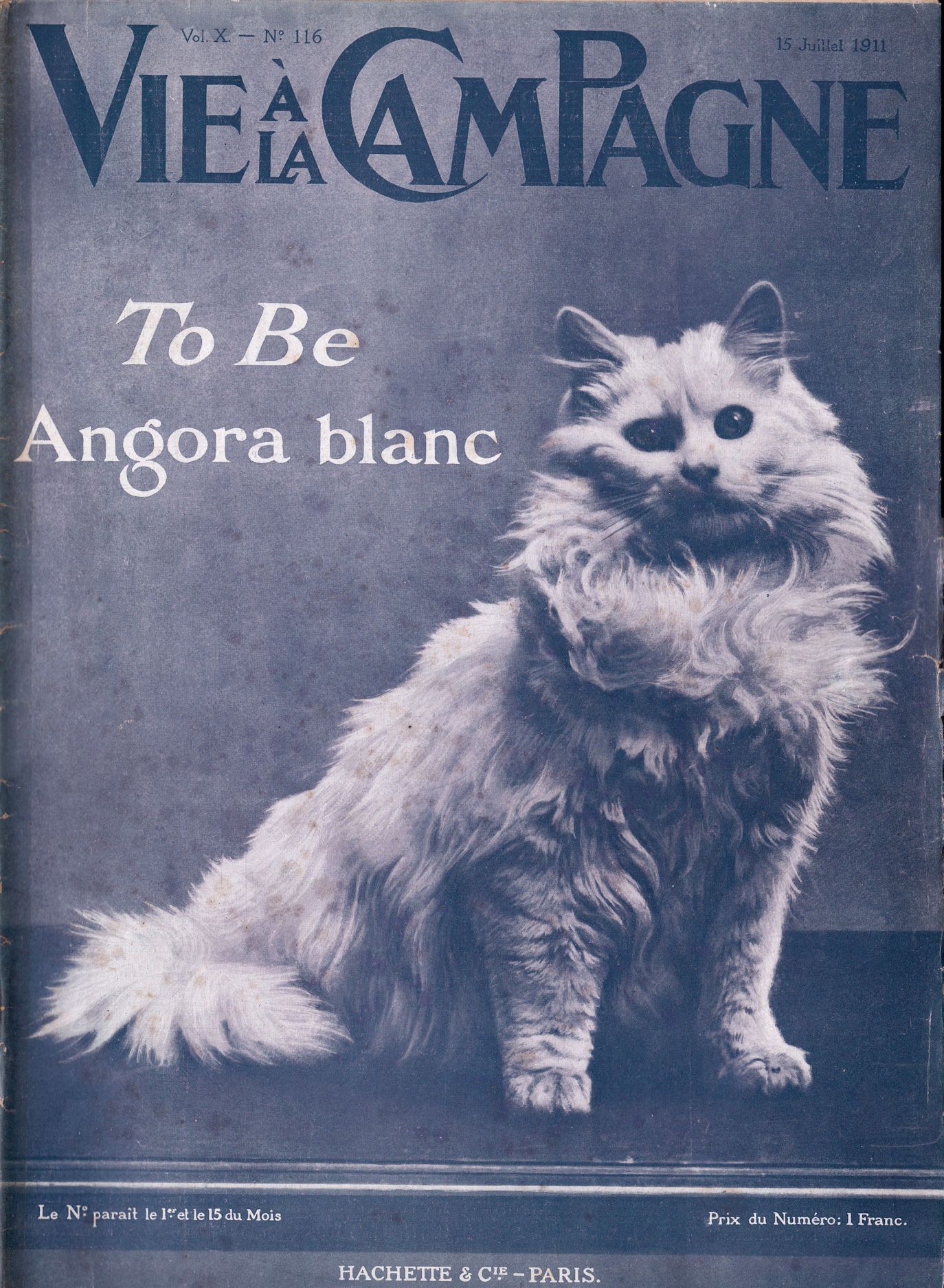
1900s VIE A LA CAMPAGNE MAGAZINE ARTICLES ABOUT CATS

RACES, TYPES AND VARIETIES OF CATS
VIE A LA CAMPAGNE, VOL X, No. 116, 15 July 1911
BREEDS, TYPES AND VARIETIES OF CATS. - THE PERSAN REGION, ORIGINAL CRADLE OF ALL LONG HAIR CATS. - HOW THE ENGLISH CREATED BEAUTIFUL TYPES.— THE COLD-SENSITIVE SIAMESE IS THE REAL HUNTER IN THE APARTMENT.
IN TRUTH, from the start of time, while many animal varieties have undergone metamorphoses, the feline type has remained immutable, independent even in its anatomy! It is therefore very difficult to draw up a family tree for the Cat, in the same way we do for the Dog. The most characteristic species is the "European Tiger-Cat", a kind of wild cat (Félis catus), which is found in all large forests.
TWO LARGE SPECIES, LONG-HAIRED AND SHORT-HAIRED
Among the domestic breeds alone, they seem to emerge from a large confusion of species, because two similar types, one long-haired and the other short-haired - derive from more or less distant crosses with wild cats from various parts of the world and some species native to Asia Minor.
The Persian region of "Angora" has always been recognized as favouring remarkable types of furry animals of various kinds that are born in its wonderful climate, so the name "Angora" has remained attributed to any Cat with a long, thick, silky coat. The Cats known as Persian, Syrian, Spanish, Italian, and, in France, the Chartreux, belong to one and the same species.
Originally, the real Angora Cat had a splendid white coat and faience-blue eyes, but for centuries, the changes brought about by the domestication and the emigration of the oriental races (Saracens, etc.) in Europe led to various colours and, even in Persia, it is today very rare to find the ancestral type with the whiteness of the Aryan race. There are also very few specimens showing the characteristic of the pure Persian cat, a uniformly single-colour coat and blue or golden eyes.
Persian dresses are nowadays: 1 - Snow-white with the obligatory blue eyes; 2 - jet-black, and also black with mahogany highlights. The latter appears scorched by the heat of the sun or tinged with henna. For these two varieties, the eye must be orange; 3 - the solid blue shade is as rare as the white; like the latter, it should have blue eyes, but sometimes it is grey-blue, and sometimes orange - which is tolerated in pure Persians; 4 - the fawn cat is considered common in Persia and, consequently, not greatly appreciated; however its fur is unimaginably rich in tone, and, under the radiance of the oriental sun, this golden fleece becomes dazzling and marvellous.
THE PERSIAN GULF AT THE EDGES OF THE MARNE.
It should not however be believed that this last variety is common in Persia. Having personally spent several months in these countries, I remember searching the whole region, high and low, to try to bring back one or two pairs of beautiful Persian cats from their country of origin – a fruitless search if ever there was one. I had to wait a long time against my will, and had almost forgotten this whim when, one fine day, I saw a long caravan of horses and camels heading through the sands of the desert towards the edges of the Persian Gulf. Curious, I approached; with the help of a few tomans (small Persian coins) I was made welcome by a camel driver and, intrigued by the strange jolts that a load of bags hanging on each side of the camels made at any moment, I expressed my astonishment to the brave nomad who, untying a wad of these bags, brought out to my great amazement a dozen superb Angora Cats tied in their traveling prison some by the leg and some by the tail. I had an answer to my riddle and a reward for my long -suffering patience; I quickly chose four beautiful cats, which he made me pay dearly for. Delighted with my shopping, with a great deal of trouble I came away with my panicked and half-wild Cats to the home of my host, who told me that twice a year the Persians embark on a journey to Bombay, from where their Persian horses are sent to the great markets of England. As a bonus, the natives take some Cats, which they round up all over Persia during the course of the year. This explanation made me suddenly understand how our neighbours in England, so passionate about Cats, managed to ensure a supply of beautiful specimens to revive and strengthen their longhaired varieties.
Indeed, the direct importation of cats from Bombay facilitates their selection, while such things did not occur in Europe since the Middle Ages until after the slow infiltration of the traveling tribes who carried their animals with their tents, among them the nomadic Cat, already a household companion, contradicting the general opinion that cats do not follow their masters.
Hence the first colour variations, the first crosses with Common Cats, and the explanation of the new coat colour varieties where white often dominates, as for example in the Italian Cat, which is generally white and fawn, and the so-called Spanish Cat, which is tricolour, that is to say, white, black, and fawn harlequin. As for the Chartreux cat, the colour is indecisive, sometimes ash grey, sometimes blue tinged with red; in all cases, a broken relationship with the beautiful coat of ancestral Cats, the blue Persians, is beyond doubt.
The Angora Cat is medium size; with long, fine and silky hair. As soon as the hair becomes woolly and the weight too heavy, we are in the presence of an animal that has already undergone several crosses in its ancestry. An exception is naturally made for castrated animals who thicken, become indolent and enormous, but are nevertheless imposing and majestic.
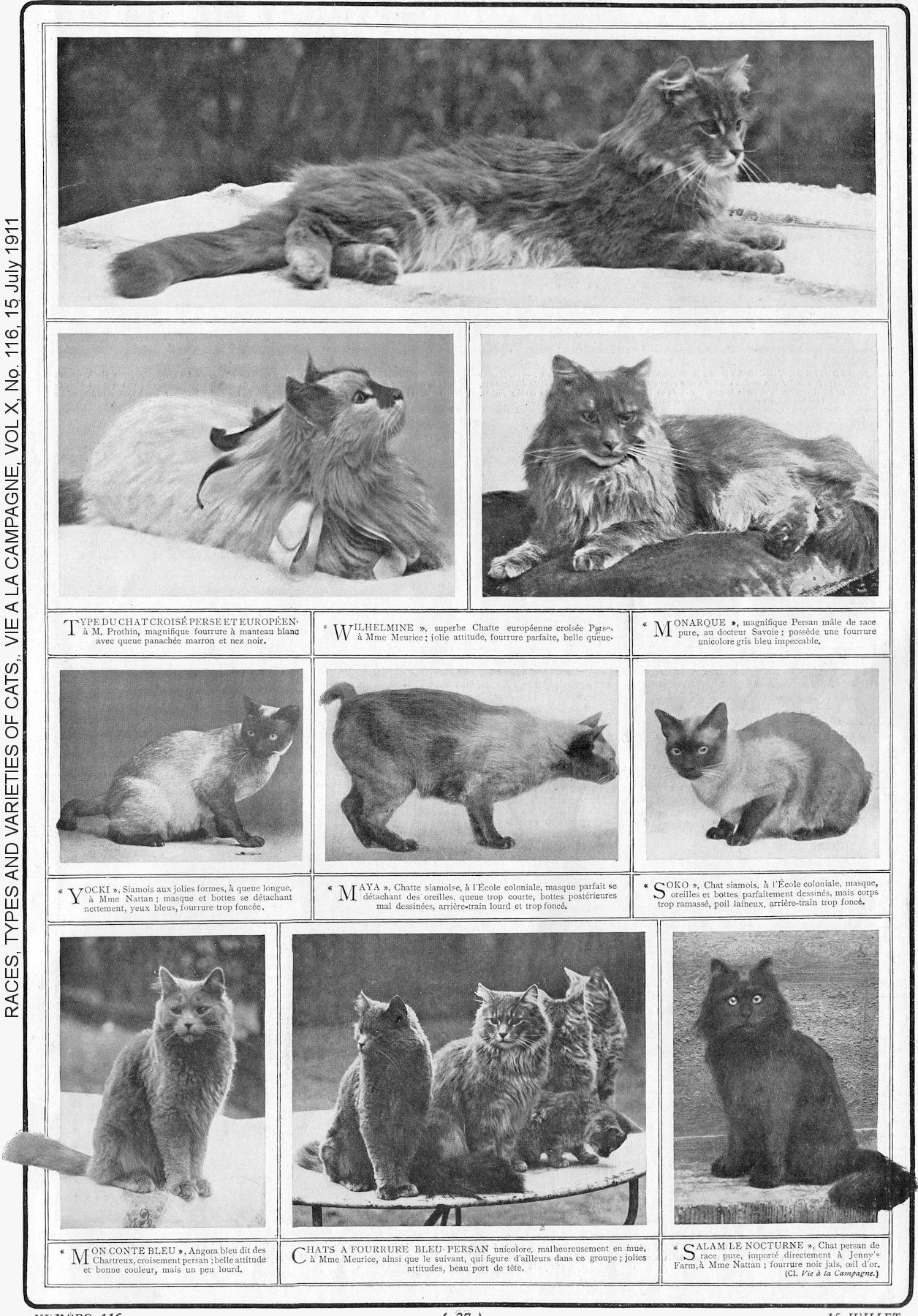
THE COMMON, OR ALLEY, CAT
Though the beautiful shimmering fur of the Angora slightly conceals the pure lines of the cat, many enthusiasts or artists prefer the short-haired cat, or even the plain tabby alley cat, which differs from its Wild Cat ancestor only in its noticeably larger size, and whose coat is crisscrossed with characteristic long wavy bands. The common type has several colours and patterns and produces, according to multiple crosses, different colours: black, white, yellow, grey with stripes, zebra-stripes and various markings. Its nose, lips and paw-pads are slightly tinged with black; it is sometimes called, due to variations in its coat, the "Variable Cat". This animal, left to itself, quickly adopts the free and wandering life in the woods, and the colour of the Tiger-cat, commonly known as wild. The good big tomcat must be confined to the farm; it is very rustic and sociable and does a great service by exterminating rats and field mice, and even small snakes, because it should not be forgotten that in Egypt, it was the duty of Cats to rid the region of the snakes and rats that devastated the crops.
THE SIAMESE CAT IS THE TRUE APARTMENT DWELLER
For the ideal apartment cat, there is no hesitation; if we like Cats with a short coat, the Siamese is recommended, contrary to certain ridiculous and erroneous prejudices against it, which describe it as a wild and naughty Cat. I have been raising them for years, and I can confirm that there is no sweeter, friendlier, or more affectionate Cat. It is never rude, and always has a gracious attitude. The females are remarkably affectionate and cuddly; their savage instinct is never be revealed if in the house, sometimes, unless the untimely passage of a mouse and (sometimes in the countryside of a rat) suddenly transforms it.
The Siamese is the real apartment hunter; with the admirable dexterity that characterizes his breed, with a single blow of his powerful claw he pierces the skull of his enemy and instantly kills the largest rodent. Then, after having watched for hours, the Siamese abandons its victim on the ground, even disdaining to keep it like a toy and far too refined to eat it, while the vulgar Cat breaks the back of its prey and devours it.
The wild cats of Siam’s forests are red in colour, often dotted with round black spots. The domestic cat, raised in the court of Siam and hence called the "Royal Siamese", must be absolutely white at birth. The purer white a Kitten is, the more expensive it is. However, it will darken slightly as it ages.
Then, at around three months, the white becomes cream, and a curious colour contrast develops, making the Siamese distinctive. The lower legs become dark brown almost black; an eye mask develops on the face, and the tail develops the same colour, contrasting with the uniform cream colour of the body. I compare it to the Russian Rabbit. The eyes are blue, sometimes very intense, sometimes very pale; among the two or three kittens of a litter, there is often one which has the broken or twisted tail, or a tail that ends in a knot; this is a peculiarity which is often found in the Siamese breed, however it does not exclusively confirm breed purity. Often two Siamese with normal tails, brought directly from their country of origin and selected there, hence known to be perfectly pure, indiscriminately produce kittens both with and without a knotted tail; naturally the merchant, knowing that the public is aware of this peculiarity, emphasizes it and confirms it, and in some way exploits it. There are those who mutilate young kittens in order to satisfy their customers and, of course, to increase the prices of the short-tailed Siamese.
In general, the Siamese is smaller than the European Cat; males, however, are even stronger than females. It degenerates fairly quickly, therefore, it is necessary to reinvigorate the blood by importing pure specimens to strengthen the breed, and to avoid inbreeding even more than in other animal species.
A TAILLESS CAT.
To close this brief naming of Cat varieties, I would add that there is another sub-Variety completely devoid of tail, the result of importing Cats from the Far East (Siam, British Indies, Malay Archipelago), and crossing them with the Common Cats of the British Isles. This variety is more particularly attached to the Isle of Man, in the Irish Sea. It is referred to as the "Tailless Cat", that is to say completely without tail. This Cat occurs in in colour varieties. At the Jardin des Plantes in Paris, there are two that completely resemble the striped alley cat; there are also blacks.
All Cats are interesting to breed and study; each has its own character and its own nature. Madame Michelet, the wife of our great historian, knew how to surround herself with them and described the character of each of her kitties with charm and feeling, proving how grateful this pretty, useful and interesting animal is for the care which surrounds it.
Jenny Nattan.
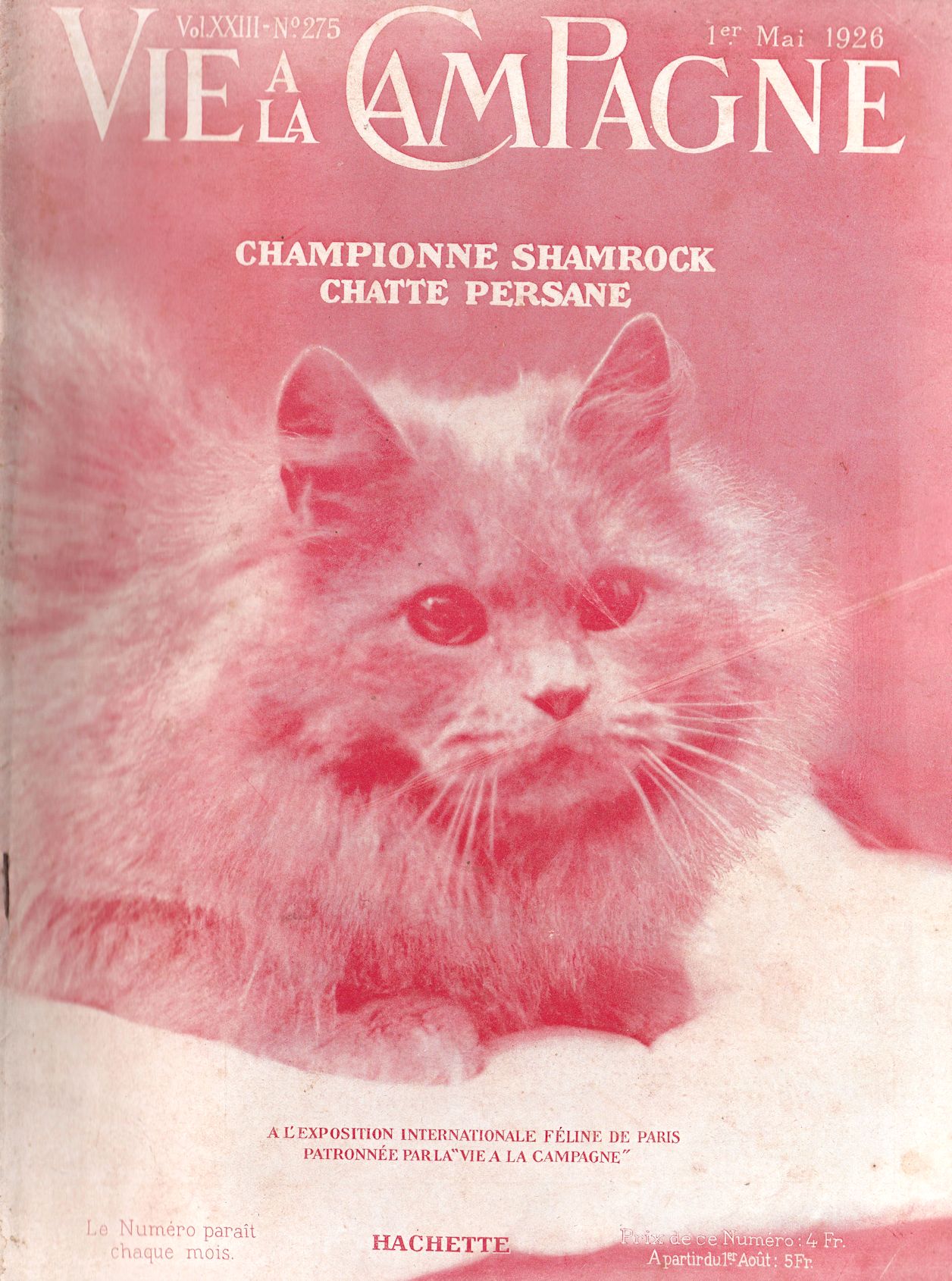
THE SPLENDOUR OF THE PERSIAN CAT
VIE A LA CAMPAGNE, VOL XXIII, No. 275, 1 MAY 1926
A BREED RENOWNED FOR ITS EXCELLENT CHARACTER, INCLUDING A SELECTION OF VARIETIES AND IMPROVEMENTS, TRANSFORMATION OF ORIGINAL MUTATIONS INTO A SERIES OF VARIETIES WITH SOLID OR CURIOUSLY STRIPED FUR.
THE PERSAN CAT with its splendid fur should not be confused with the Angora Cat. It is, with reason, one of the most splendid felines and has many admirers in England, where it is the object of 'important breeding for sale. In Belgium, we onlysee a small number of very beautiful subjects, as well as in France, where we finally started Breeding this Prince of Indolence and Somnolence.
Origin. The Persian Cat is originally from Syria, where the ancestral type can still be found, self-colour, blue, white or orange, it is characterized by its long and fine coat. Breeding, practiced on a large scale in England, where it is very fashionable, made it possible to fix and select a series of mutations, such as several varieties with particular characteristics: colours, patterns, self-colours, particolours, eye colours, etc.
For a long time, we wanted to divide long-haired Cats into two classes: Angoras and Persians, the former differing from the latter in a few physical features: more angular head, less bushy and longer ears, pointed tail, etc. This overly artificial classification has not persisted, and the ordinary Angora is currently considered to be a degenerate or weakened form of the Persian.
CURRENT STATE OF BREEDING.
As with the majority of animal breeds, it is the groups, breeding syndicates, clubs, societies, etc., which, have made it possible to coordinate, unify efforts and codify directives, and have laid the relatively stable base for improvements needed. In 1887, the National Cat Club was founded in London, which organized the first feline events which were increasingly attended and significant. The number of exhibitors, small at the start, has increased each year, and the subjects exhibited have improved. Now, thanks to patient selection, apart from a few classes that are still scarce due to breeding difficulties, the English have reached perfection or are approaching it for the self-coloured Persians
In France, the "Cat Club" was founded in 1913; but its efforts were annihilated by the events of 1914 to 1918. Since the war, the breeding of Persian Cats tends to be spreading with us; it is starting to be favourably thought of, but beautiful specimens are still quite rare and scattered around. The Exhibitions which take place annually in a few cities - Lille, Marseille, Cannes, Angers, etc. - have helped to make it better known, and hopefully we will soon see the Persian cat occupy a well-deserved place of honour like the Apartment Dog, just as it does in England.
The big international cat event of May 14 and 15, organized by the Cat-Club of France, under the patronage of Vie à la Campagne and Fémina, which has received 150 entries to date, promises, moreover, to be a great success, which is an indication of the interest that the general public currently takes in varieties, recognised cat breeds, and in their breeding.
ESSENTIAL CHARACTERISTICS.
The ideal type of Persian Cat, whatever its colour, has the following physical features.
General appearance: fairly robust animal, although very elegant in shape; with abundant silky fur, particularly well developed around the neck, on the chest and spreading out in a sort of ruff. This heavy coat helps give the animal a majestic appearance, sought after by breeders based on the idea that the more imposing the animal, the more beautiful it is.
Head and neck. Head: round, very expressive, thanks to its large, wide open eyes, which give it an alert and intelligent look. Ears: small, widely separated, furnished with a tuft of hairs arranged in plumes emerging from the interior of the organ. Nose: short and thick. Cheeks: well developed. ruff: long and bushy, giving the face an impressive character.
Body and legs. Body: long and supple. Tail: relatively short, well furnished with very long hairs arranged regularly, giving the tip a rounded shape. Legs: massive, short and strongly boned, terminating in a broad, tufted foot. Fur: lacking, unfortunately, for part of the year, during which time the animal is not always assessed at its true merit, retaining a greater importance in neuters which are, in fact, even more imposing than the stud cats.
DISQUALIFYING POINTS. Coarseness of the form. Head: elongated with a pointed nose. Ears: too long, not tufted and too close together. Eyes: small and oval. Hollow cheeks. Legs: too long and too weak. Foot: narrow and not tufted. Tail: pointed appearance, poorly furnished. Rough hair. Fur not abundant enough.
QUALITIES, DEFECTS, ABILITIES. The adult Persian cat is a fairly robust animal. Exceptionally soft, it only rarely scratches when it is irritated by the presence of another cat or a stranger that has frightened it. He knows his master very well, and lets himself be handled without complaint, and he shows him his feelings by fawning and simpering. Slightly indolent, he gets used to living in an apartment very well, but he has little aptitude for hunting mice.
CLASSIFICATION. Persian cats are classified according to their colour: White Persian, Blue, Black, Silver, P. Chinchilla, Smoke, Orange, Cream, Tabby.
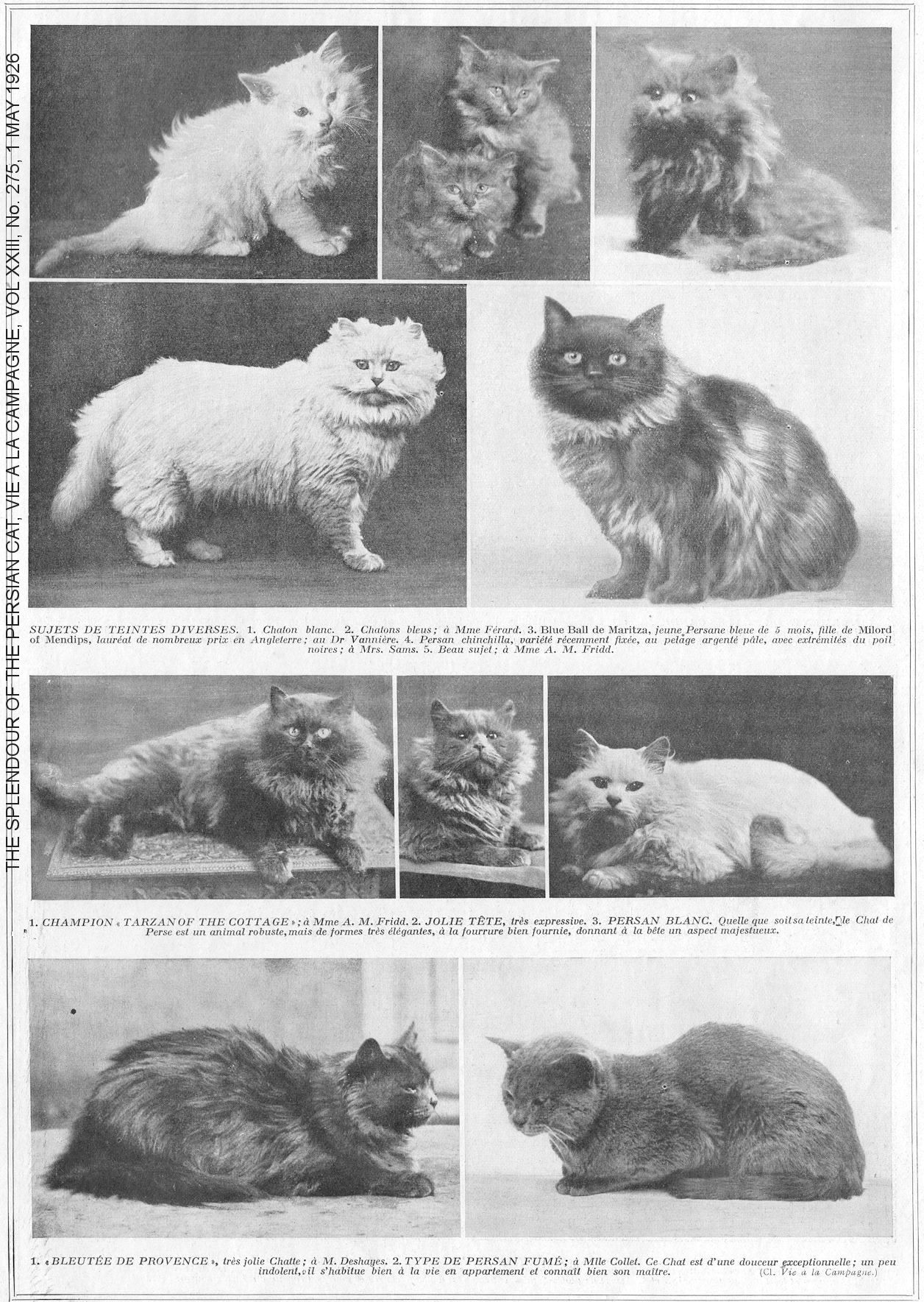
WHITE PERSIAN CAT. Origin. The white Persian Cat, native to Asia Minor, where it was commonly found in the past, is now quite rare there as a result of crossbreeding with foreign varieties.
ESSENTIAL CHARACTERISTICS. Regardless of the characteristics mentioned above: large head; wide-set ears, etc., it has a snow-white coat and azure blue eyes. Its fur is more silky than that of othe colour Persians. Alluring animal when in its full beauty, but its coat requires diligent and daily care; it is almost always deaf.
SCALE OF POINTS. Colour, 25; Coat, 25; Size and shape, 20; Head, 10; Eyes, 10; Beauty and general appearance, 10. Total: 100 points.
DISQUALIFYING POINTS. Fur: black hairs in places and fawn shades. Eyes: too light (often, even in well-bred specimens, the eyes are different shades, one being blue, the other green or yellow).
MAIN CHAMPIONS. Males. French: Ch. Pharmacy of Mayfield. English: Ch. Minley Roseacara, Ch. Minley Coming Star, Ch. Minley Surprise. Females. English: Ch. Sensation of Hounslow; Ch. Swinton Heartsease.
BLUE PERSIAN CAT. Origin. The original type once existed in Persia, where it is currently very rare. Pietro della Valle, quoted by Buffon, gives the following description: “There exists in Persia a species of Cats originating from the province of Chorazam. Their size and shape resembles that of the ordinary cat; their beauty consists in their grey hair, without ‘speckles’ or spots, which is the same colour throughout the body, being a little darker on the back and head, and lighter on the chest and belly, pleasantly tempered with chiaroscuro as the painters call it, which is a marvellous effect. In addition, their hair is loose, fine and lustrous, delicate like silk, and so long that, though it lies flat, it nevertheless forms few ringlets, especially under the throat. These Cats are to Cats what Barbets are to Dogs, and the most beautiful part of their bodies are their tails, which are very long and entirely covered with hair that is five to six fingers in length; they spread it out and carry it over their back like squirrels, tip upwards, in the shape of a plume. They are highly prized. The Portuguese took them from Persia to India. The author adds that he owned 4pairs, which he intended to take to Italy.
ESSENTIAL CHARACTERISTICS. The Blue Persian Cat presents a beautiful blue shade with varying highlights. All shades of blue are allowed, but breeders now prefer the lighter ones, tending towards lavender-blue, but it is difficult to retain this colour over successive generations. From the first breeding efforts, green-eyed cats were allowed at shows. Orange eyes, which are much more attractive, were then required, and there is no longer a Persian Cat worthy of the name who does not have yellow eyes at least. The colour varies from golden yellow to dark copper yellow or orange.
STANDARD, SCALE OF POINTS. Fur: all shades of blue are permitted without marks, shading or white undercoat. Long, thick fur, soft to the touch. Well-developed ruff, 30. Head: broad and round with wide-set ears. Short face and nose. Ears: small and tufted inside. Cheeks well developed, 25. Eyes: orange, large and round, 20. Body: stocky and set low on the legs, 15. Tail: short, well furnished, not ending in a point, 10. Total: 100 points.
DISQUALIFYING POINTS. Fur: uneven shade. Darker shade on the back than on the sides and legs. Hair: dull, white hairs. Shadows, red reflections in the fur. Eyes: greenish in colour.
MAIN CHAMPIONS. Males. English: Ch. Azure of Hadley; Ch. Blue Jacket; Ch. Neilla Billie of Thorpe; Ch. Sir Archie II of Arandale. Females. French: Ch. Shamrock. English: Ch. Misty Morning; Ch. Regina of Emberton.
BLACK PERSIAN CAT. Less common than the blue Persian, however, this cat enjoys considerable popularity. He has a very vivid colour and beautiful dark yellow eyes.
SCALE OF POINTS. Colour, 25; Coat, 25; Size and shape, 20; Head, 10; Eyes, 10; Beauty and general appearance, 10. Total: 100 points.
DISQUALIFYING POINTS. Fur: dull with red or tawny highlights. Hair: white hairs. Eyes: too pale.
MAIN CHAMPIONS. English. Males: Ch. Heathside Flanark. Females: Ch. Sally Cat; Ch. Zulanda. |
SILVER [TABBY] PERSIAN CAT. ESSENTIAL CHARACTERISTICS. This variety has a bright, light silver coat, marked with very clear black stripes all over the body.
Ideal markings: dark stripe along the spine, tapering from head to tail; numerous well separated concentric black rings on the chest; ringed legs with black markings getting smaller approaching the feet.
STANDARD, SCALE OF POINTS. The silvery striped “Silver Tabby” Persian Cat “is a pale silver colour, with very distinct black markings; never any brown markings or cream shades which are disqualifying points. Green eyes. Head and expression, 25; Colour and markings, 25; Eye colour, 10; Fur and condition, 20; Shape, 10; Tail, 10. Total: 100 points. |
MAIN CHAMPIONS. English: Ch. Buffalo.
CHINCHILLA PERSIAN. The Chinchilla Persian is one of the most recently fixed varieties. In 1919, a society was established in London including the breeders of Silver and Smoke Persians. For the purpose of selection, the members decided to create two classes called Silver or Self Silver (solid silver) on the one hand, and Shaded Silver on the other. No Self Silver specimens have been obtained to date, and this class is still devoid of entries at shows. To fill this gap, judges decided to consider the less shaded specimens as Self Silver. Faced with the difficulty of clearly separating the two classes, that of the Self Silver was abolished, and its subjects were called Chinchillas. This animal is derived from the Silver [Tabby] Cat but differs from it in having an unstriped coat.
ESSENTIAL CHARACTERISTICS. Very pale silvery hue, from the muzzle to the tail, with black tipped hairs giving the coat a shade of strong ticking. Very bright colour. At first, yellow eyes were tolerated; today they must be green.
STANDARD, SCALE OF POINTS. Colour: preferably the palest silver colour, almost white at the root. No dark stripes or tawny hues. Ends of long hairs are dark, giving the fur the appearance of having been peppered with black, but remains very pale overall, 30. Fur: long and thick, 20. Hair texture: 10. Tufts of hair in the ears, around the ears and on the feet: 10. Shape: back very horizontal, not too short, legs short with round paws, short tail, carried low, 20. Eyes: large, brilliant, green in colour, not yellow or orange: 10. Total: 100 points,
MAIN CHAMPIONS. English: Ch. Cupid of Hyver; Ch. Langherne Beauty.
SMOKE PERSIAN. The Smoke Persian (smoky blue) should be black shaded with smoky grey, with a silver undercoat as clear as possible. During the moult, the colour is blackish. Well developed, shiny ruff. Dark orange eyes.
SCALE OF POINTS. Head and expression, 20; Eye colour, 15; Undercoat colour, 10; Absence of markings, 15; Fur and condition, 20; Tail, 10; Form, 10. Total: 100 points.
MAIN CHAMPIONS. English. Male: Ch. Dannyman of the Cottage; Female: Ch. Daddy's Darling.
ORANGE PERSIAN CAT. The Orange Persian Cat is divided into three sub-varieties: Self orange (solid orange), Tabby orange (striped orange}, Shaded orange. Solid orange Persian Cats are the rarest, being very difficult to obtain without spots or stripes. The more numerous Orange Tabby Persian cats have a very bright coloured coat marked with dark orange stripes, very sharp, regular, and as symmetrical as possible. The great difficulty is to obtain specimens with a well-balanced shade.
STANDARD, SCALE OF POINTS. Colours and marks: as shiny as possible: 25, Fur: silky, very long, fluffy: 25. Size and shape: robust, without coarseness, but massive, well built; short legs: 20. Head: round and broad; short nose, small and wide open ears: 15. Eyes: large, bright orange or brown: 5. Condition: 10. Total: 100 points. Independently of the faults reported above, the Orange Cat must not show white spots. . 100
CREAM PERSIAN. Origin. The Cream Persian is derived from the orange Persian Cat and Tortoiseshell Persian. It is a variety entirely created by mutation and fixed by selection.
ESSENTIAL CHARACTERISTICS. Colour straw-yellow, without trace of white, orange or blue. Very uniform fur. Ears and tail must not be darker in shade than the rest of the body. Beautiful specimens are very rare, most of those obtained so far being too dark in colour; it is very difficult to obtain them without marks or shadows.
STANDARD, SCALE OF POINTS. Colour: pale or darker shade as pure as possible, without markings or shadows, dull shades are to be rejected. Very pale fawn tone is desirable, 25. Fur: very long and fluffy: 25. Size: strong, without coarseness, massive and strongly boned; short legs: 20. Head: round, broad, with short nose, small and well opened ears: 15. Eyes: large, bright orange or brown in colour: 5. Condition: 10. Total: 100 points.
TORTOISESHELL PERSIAN. Origin. The Tortoiseshell Persian was created by mutations and fixed by selection like the cream cat and is still in the process of improvement. It derives from crosses between Black Persians and Orange Persians.
ESSENTIAL CHARACTERISTICS. Has a distinctive coat which is very pretty when the colours are bright, regularly interspersed black, orange and yellow spots, the size of which varies from fleck to patch. To date, it has been impossible to obtain males of this variety, hence the difficulties experienced by breeders in obtaining well-marked subjects.
STANDARD, SCALE OF POINTS. Colour and markings: the 3 colours, black, orange and yellow, to be as distinct, brilliant and defined as possible; no stripes or trace of white: 30. Fur: very long and fluffy: 30. Size and shape: strong without coarseness, massive and strong boning, short legs: 25. Head: round, short nose, small well-opened ears: 15. Eyes: wide and full, bright orange: 5. Condition, 10. Total: 100 points.
FAWN STRIPED PERSIAN. The “Brown Tabby” Persian Cat (fawn striped), is frequently very large and has a bright sable or fawn background colour, marked with brilliant black stripes, very vivid, regularly arranged on the spine and symmetrically on the body and paws. The markings are concentrically arranged on the chest. The background colour should not tend towards orange The eyes are orange.
STANDARD, SCALE OF POINTS. Markings: black, as distinct as possible; no spots on the back, sides and chest: 25. Colour: fawn or sable; no white: 25. Fur: long and not coarse: 15; Head: large and round, small ears, short face, not pointed. 10, Eyes: orange or brown: 5, Shape and size: stocky, strong boning, set low on the legs, good size without coarseness: 10. Condition: 10. Total: 100 points.
MAIN CHAMPIONS. Ch. Garboldisham Mascot, Ch. Surprise Packet.
CHOICE OF BREEDING STOCK. The Persian Cat is quite fragile during its first year of life. Do not let it breed for at least a year; instead devote this period to its development. This remark is especially important for young males, because many beautiful subjects have been sacrificed due to premature use. Use only those subjects that are in perfect health, with perfect fur, for breeding. Consider these two points: the physical qualities, the permissible pairings that will ensure the required colours.
PHYSICAL QUALITIES. Choose a male with a certified pedigree, well built, strongly boned, with a short, broad nose, a broad head with the widest possible space between the ears. As far as possible, pair together two specimens that correct each other’s faults: for blues, if the cat has eyes that are too pale or an incorrect shade, match her with a male with strong orange eyes, and vice versa.
COLOUR ASSOCIATIONS. First observe the following rule and do not break it at any cost: never pair a self-coloured cat with a tabby; this misalliance produces specimens with shadows or markings: disqualifying points. Only pair whites, chinchillas or smoked with each other. An exception is to pair blues with blacks in order to darken the hair or brighten the eye colour, which is very beautiful and rich in blacks. If you want to get blues, preferably mate a black female to a blue male, the reverse combination almost always gives mostly black offspring.
The breeding of plain or shaded orange Persian Cats is exciting due to the variety of shades that can be obtained and the paths available from the point of view of selection. The orange cat, bred to a black male, usually gives half a litter of orange and half a litter of tortoiseshell, and an interesting detail to note is that oranges are mostly males and, tortoiseshells are females. The tortoiseshell Persians thus obtained can be mated to a blue male, resulting in oranges, tortoiseshell and creams. The latter are quite rare, and so far we have only been able to obtain subjects that are too dark.
Only mate tabbies with each other (Silver tabby, Brown tabby). Regarding the choice of male, pay great attention to the arrangement of the markings, which must be regular and well defined. There are some advantages in mating father to daughter, and son to mother, provided you do not abuse this method.
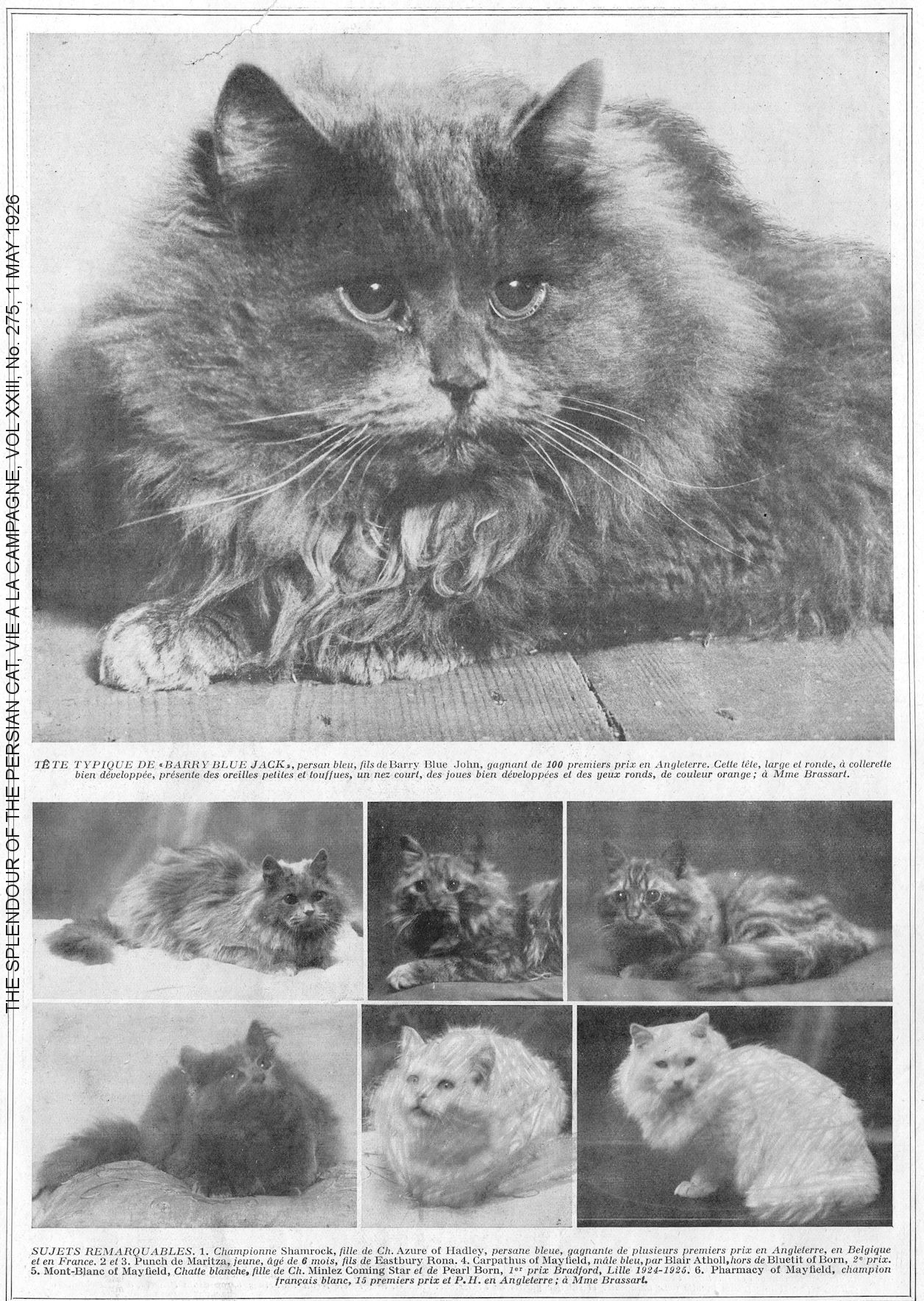
MANAGEMENT OF BREEDING. As soon as she returns from mating, place the female in the room where she will give birth. Avoid handling her too often; leave her alone, avoiding the presence of strangers. When the kittens' birth date is close, prepare a box with a cloth that easy to disinfect with antiseptic. Do not allow strangers to enter the room, the presence of unknown faces will frighten the mother and encourages her to move and hide her kittens. Provide her with a more generous diet, but not excessive.
During the birth, watch the mother because, if it is a large litter, a tired mother does not take care of the first kittens born. Take them gently to warm them in a flannel cloth, but, as far as possible, only do this short separation if it is absolutely essential. If the range is too big, make sure you have a replacement nurse. This can be a European shorthair cat, although the kittens raised by such a foster-mother do not become such beautiful specimens. Otherwise, destroy the kittens that have defective fur, always a difficult choice, especially among self-colours. In tabbies, the coat is easy to assess, so sacrifice badly marked individuals.
TREATMENT OF THE LITTER. If the litter is too strong, provide a wet-nurse or remove a few kittens that have faults. This operation is always risky, especially among self-colours; on the other hand, in tabbies, the pattern is easy to assess so that you can judge the value of kittens and remove badly marked individuals. As a guide to the number of young to keep, this depends on the strength of the mother; a good strong female can feed five kittens until weaning; however, the best results are often obtained with just four kittens.
When you need to use a wet-nurse, choose a strong European female that has given birth at the same time or a few days apart. Remove two or three of her kittens during her absence and immediately replace them with the same number of Persian Kittens that you want to entrust to her, so that she does not notice the substitution. Watch the nurse and give her a more generous diet. Note, however, that Persian kittens taken from the mother and nursed by a cat of another breed are often more puny. Do not handle the kittens. Leave them in their mother's care only. As soon as they start to leave the nest, around the age of three weeks, provide them with one or two boxes filled with sand to accustom them to cleanliness. At around the age of 6 months, begin to give them milk in small quantities; gradually increase the ration and supplement it with fish and gradually move on to minced meat given three times a day at 8 weeks old. Leave the Kittens with their mother until 2 months old, when they can be completely weaned.
Parasites: intestinal worms and fleas are the biggest enemies of kittens. Since their intestines are very fragile, many die from worm-related verminous enteritis; in more resistant subjects, the fur is compromised and remains dull. As they are very intolerant of most remedies, avoid using medication without veterinary advice before the age of 3 months. Weigh the kittens to check their development. Perfectly healthy kittens normally grow about 500 gr. per month. Avoid cold which often causes youngsters to develop a type of coryza which can sometimes be fatal, and conjunctivitis which is very difficult to treat.
Perform the final selection around 3 months. You can, at this age, discern the eye-colour in self-colours, and also the required physical qualities: width of the head, shape of the nose, length of the ears and tail, size of the legs, etc., in a word, on the essential characteristics in the breed standard for an ideal specimen.
TREATMENT OF ADULTS. Give adults three meals a day. Exercise great surveillance over the quality of food, the most common disease of cats being enteritis. Vary the rations widely. Alternate the distributions of raw meat with those of cooked meat; add a little macaroni, rice or vegetables. Fish is also a food of choice; preferably give it boiled. Milk is not recommended because, though some cats tolerate it, it causes enteritis in others. Give it occasionally in cases of constipation, otherwise the usual drink should be pure water. Make a pot with couch grass available to your cats, as grass is essential for their health. To prevent deterioration, treat your cat’s fur as you treat your own hair. Comb Cats daily; brush and clean them from time to time with a dry shampoo.
Persian kittens can be rehomed after weaning at around 2 months. Their price varies according to the beauty and colour of the fur, from 300 to 800 fr. Adults sometimes reach very high prices: pedigree specimens are never sold for less than 1,000 to 2,000 francs. Breeding animals have been sold in England for up to 140 pounds, and since a pound is 130 fr.,that is in the region of 18,000 fr.
MAIN CLUBS. In England: the National Cat Club, founded in 1887; the Northern Counties Cat Ciub, founded in 1900; the Persian Smoke and Silver Club, founded in 1900; the Blue Persian Club, founded in 1901; the Orange, Fawn, Cream and Tortoiseshell Persian Club, founded in 1900; the Black and White Persian Club, founded in 1900. In France: the Persian Blue Persian Club, affiliated to the "Cat Club of France".
INTERNATIONAL CAT SHOW. Magnificent French and foreign Persian cats will be presented at this first major post-war show organized by the Cat Club of France and Belgium, under the patronage of Vie à la Campagne and Femina, at Salle Wagram, Paris, on 14 and May 15 next. Do not miss visiting this Exhibition.
Mrs. L. BRASSART, Vice-President of the Blue Persian Club, affiliated to the Cat Club of France.
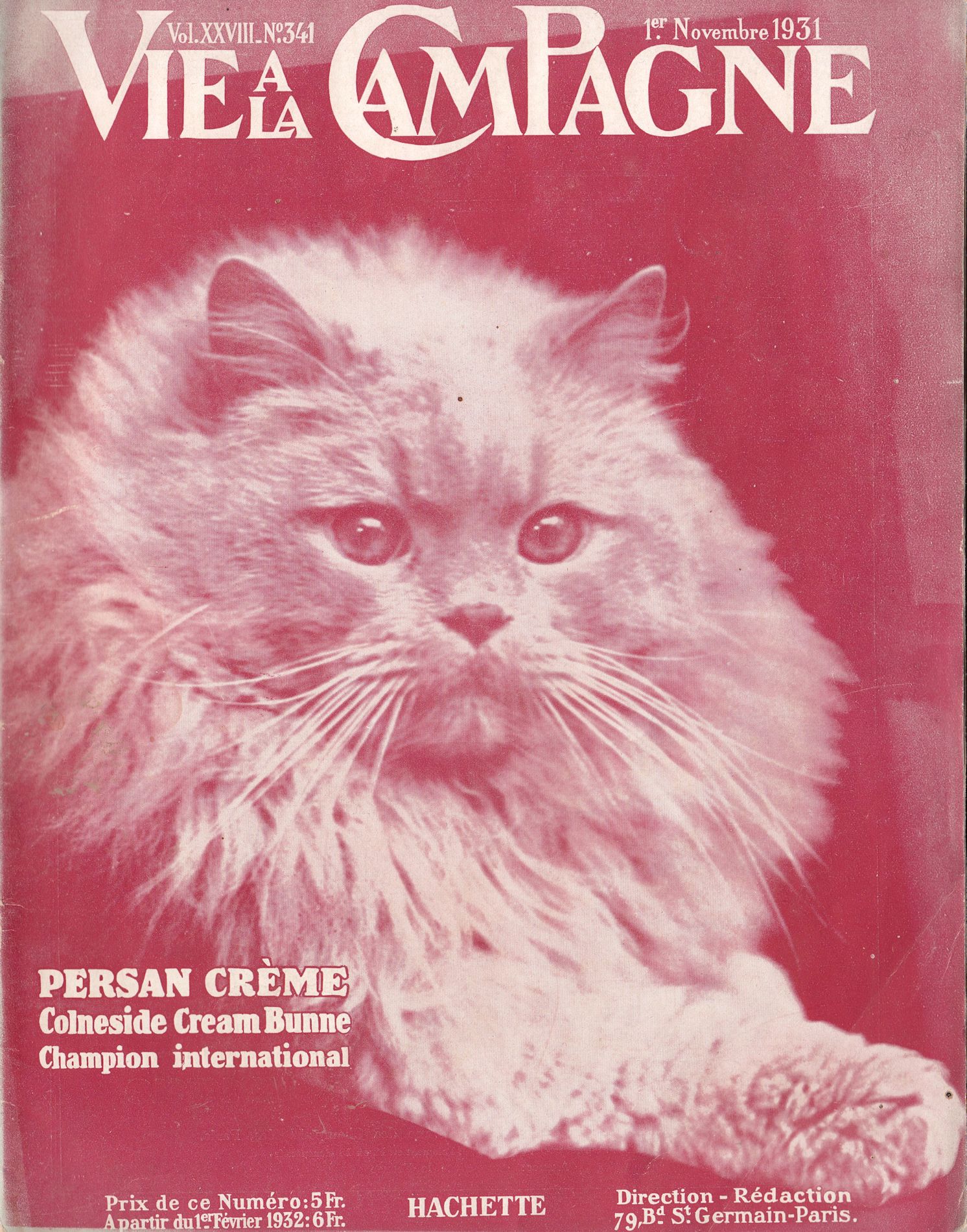
FOR CAT AND DOG LOVERS
VIE A LA CAMPAGNE, VOL XXVIII, No. 341, 1 NOV 1931
THE UTILITY CAT. . To destroy the swarms of rats whose material damage amounts to billions each year, numerous means are recommended. But rats are essentially migratory creatures. When you apply a method of destruction, the rats flee the danger zone, emigrate, and create new colonies elsewhere, then some return when the danger has disappeared. This is why it is necessary to have recourse to the cat, but to a specialist robust ratting cat, and not to the usual house cat; it has degenerated, and has lost a lot of its instincts to destroy undesirable rodents.
Breeders, including Dr. Loir, rightly believe that most cats have the instinct to hunt Mice and Rats. The reason the Cat often gives up hunting is because it does not feel robust enough to engage in a possible fight. It is a mistake, as we have previously said, to starve the Cat to force it to hunt. It is necessary to enter into the psychology of this feline and understand that this cunning animal, being an excellent judge of athleticism, does not attack if there is a chance of failure.
Therefore, we must have vigilant, vigorous, robust Cats with rodent hunting skills. Select and breed those who demonstrate these instincts; build up rehabilitated lines, as Dr Loir has done, with his stud cat Lico, winner of the Ratting Cat Cup, and endowed with the quality or prepotency. It is a cat of the so-called "common" species, with a beautiful tabby coat, very long whiskers, and robust claws. His size is unremarkable, but he is exceptionally agile, and the main thing is that he is a ruthless hunter. Sometimes he stays on the lookout for a whole day, without making a movement, and only leaves when he has the opponent between his teeth.
Everything suggests that such valuable specimens are likely to be sought after. Their breeding, as well as their selection, deserves serious consideration.
C. de M.
AN OUTSTANDING CREAM PERSIAN
VIE A LA CAMPAGNE, VOL XXVIII, No. 341, 1 NOV 1931
THE COVER of this issue shows a magnificent cream Persian Cat, Colneside Cream Bunne, who was declared international champion in Reims in April 1931 and is the son and grandson of 2 famous English champions: Colneside Billy Bumpet and Azure of Hadley. Before coming to France, his competitive career in England was triumphant: judged champion 10 times, notably in Kentish Town in 1929 and 1930, and at the Crystal Palace show in 1929. In these competitions, where the competition is very stiff due to the number and merit of the specimens, the title of champion has great value. Indeed, in England, cat breeding is practiced on a large scale and, in a championship competition, the stud who wins the title of champion of champions: best in show (the best cat in all the classes of the show) competed against a large number of valuable studs. With such a title, a cat sometimes commands a value of 10,000 fr.
Mr. Fournier, current owner of Coineside Cream Brunne, specifies that the Persian cat must be very strong (a well-made stud weighs between 5 and 7.5 kg.); its hair must be very long and form a magnificent ruff around the head, which must be well rounded without any tendency towards being pointed. The nose should be short and wide, the eyes round and well open, coppery red or blue coloured depending on the variety, the ears small and wide apart. However, Persians conforming in all points to this standard are quite rare and are most often found in the blue Persian variety.
The cream Persian is a particularly pleasing colour, and there are very few perfect specimens of this variety; the difficulty in producing them, therefore, provides even greater satisfaction. Avoid the following defects: nose too long, ears too large, stripes or orange spots in the hair. To obtain a beautiful strain of cream cats, start with things that are as perfect as possible. It is particularly difficult to produce females conforming to the standard. Crossing with good blue individuals is sometimes useful, and it's the only cross that isn't too dangerous to the colour.
BREEDING SIAMESE CATS
ORIGINATING in Siam, this cat is naturally sensitive to cold. Keep the breeding premises at a temperature of 18 Centigrade (15 Centigrade for adults) advises Mr. Delangle, to avoid chills.
The female is pregnant for 65 days and gives birth from 2 to 6 kittens; the young are born white, but darken fairly quickly. If the litter is too strong, remove a few kittens or overfeed the mother. For adults, give 2 meals a day, noon and evening, including: cooked calf liver mixed with a little bread soaked in the cooking juices, raw calf liver, beefsteak, roast beef, rare but cold mutton leg cut into small pieces, cooked and cold fish (hake), mixed with lightly cooked rice, spleen and lung. Avoid grease and especially sauces.
Give kittens 2 daily meals from the 5th week. Baked fish (hake) cooked in court-bouillon and extend it as long as possible. Sole is particularly suitable during the first days because it is very digestible.
As a drink, give cold boiled milk and, for kittens, add a bit of Eau de Vals to begin with, and for several days.
P. B.

TAKING CARE OF YOUR PEDIGREE CATS
VIE A LA CAMPAGNE, VOL XXXVI, No 434, 1st August, 1939.
After weaning your young subjects, concentrate your care on their feeding, and especially understand how to prevent and treat the diseases that constitute the main obstacle to breeding.
THE WEANING of your kittens, if done correctly, is now finished (Vie a la Campagne: Cat breeding: The breeding season, N ° 428; Care During Pregnancy, No. 429; Birthing, No 430; Caring for the Mother and Kittens, No. 433.) They are vigorous and well developed. They are able to grow without you having to watch them quite so carefully. However, they still need proper care. They must be fed judiciously, their hygiene must be well observed, and you must spare no effort in keeping your young charges safe from the serious diseases which await them, and which do not spare adults either.
It is still to a labour of love that I invite you today; because it is your affection for them that will be your best support and your best reward in this task.
CHAMPION ISOCRATE DE KHIVA, son of Ebbisham Glory, a female blue Persian of English origin and the famous champion blue Persian "The Autocrat of the Court." Bred by Mme Cinotti.
APPROPRIATE FEEDING
When instituting a dietary regime be inspired, above all, by the cat’s ability to digest the various foods which can be given to it, The Cat is a carnivore: its teeth and jaws are intended to catch and tear prey; its large stomach and small intestines are able to digest meat, above all. Theoretically, you should therefore only give it meat. But domestication has profoundly changed its natural habits, and eating meat exclusively is not always well tolerated, especially by those living in apartments. They do not take enough exercise to be given meat alone. This is why, although meat is the main food of my cats, it is not the only food. At this age and up to 6 months, I distribute 3 meals throughout the day, then 2 spaced meals, because they digest food slowly. Do not leave food continually available to the cat; Accustom it from an early age, to the leftover mash being removed to allow his digestive organs to rest regularly.
Give preference to beef that is most easily digested ; I find horse less suitable for most individuals. Raw meat, because of its vitamins, promotes the growth of the youngsters and is more digestible than cooked meat. However, lightly grilled meat is fine, and during summertime it keeps better. Cats are generally very fond of spleen and liver, but it is prudent not to give this too often as they would no longer want to accept other types of food.
Fish cooked in water (whiting and hake in particular) is a treat for them, as are sardines. I give them this twice a week, after carefully removing all the bones. The freshness of the meat and fish should be as perfect as possible.
Give on average 125 to 150 grammes of meat or fish per adult per day. Significantly increase the ration for stud cats and pregnant cats, or those nursing their young. To complete the ration, I most often add rice which must be cooked in water for half an hour (prolonged cooking promotes digestion of foodstuffs other than meat), then washed under a jet of cold water, well drained and partly dried in the oven. Pasta is also suitable, but I only ever give a little bread as it promotes intestinal fermentation, and even then I take care to toast it so that it is better assimilated. Add some green vegetables (cooked salad and sometimes chopped raw salad) to avoid constipation. Fresh eggs are also an excellent addition, especially for the young, and they are generally well digested. Fresh butter and oil are very useful; do not be afraid to incorporate them widely into the mash. I believe that milk should be avoided, at least ordinary cow's milk, as it frequently causes diarrhoea.
In summary, the mash that I give to my cats includes about 50% meat, 30% rice or pasta, 10% to 15% green vegetables and 5% to 10% butter or oil, and this mash is only slightly salted. The diet is thus well balanced and contains an appreciable quantity of vitamins whose presence is essential for growing kittens and breeding cats. That’s why I recommended sterogyl [a vitamin D supplement] for kittens. Continue using this during the first year, with calcium.
GENERAL HYGIENE
Young Cats need exercise and light; keep them in a well-lit room at a constant temperature, where they can run, jump, climb and play freely.
Daily grooming (combing and brushing) is very important. It maintains the beauty of the fur, removes dead hairs that cats usually lick and swallow, and also prevents them from getting fleas, which can transmit a variety of tapeworms to cats. A good insecticide powder will be very useful during the hot season. Just sprinkle it on the fur once or twice a week, then comb and brush the cats thoroughly to get rid of any fleas. Disinfection of the floor at the same time is essential to destroy the flea eggs and larvae that live there.
I have already drawn your attention to the need to regularly give a dewormer : monthly to young cats, and every 3 or 4 months to adults, the latter receiving a dose double that given to the young cats. Pay great attention to getting rid of worms in the females that you intend to breed and never send them for mating without giving them a dewormer.
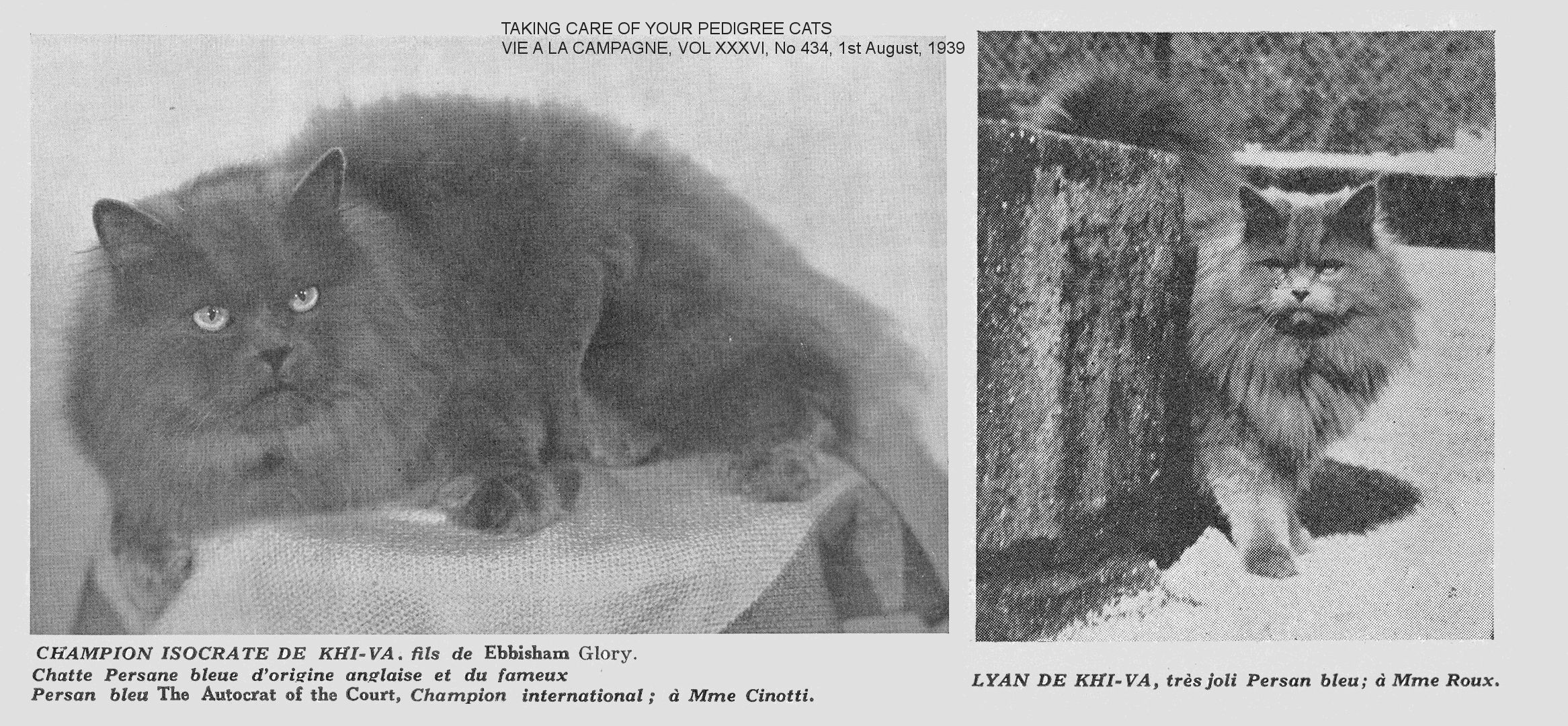
PREVENTING DISEASE
These precautions lead us to the subject of the main contagious diseases of cats, the most formidable of which are the infectious diseases. In fact, these are so contagious that they can infect all your breeding stock and quickly decimate it. It is worth studying how to prevent them.
A rule that should never have any an exceptions is to consider any new Cat that you wish to introduce into your cattery as suspect. Place it under observation in a special room, for about twenty days before allowing it to join the others. During this period, if the cat is infected, the disease has time to reveal itself and you then take all the necessary precautions to preserve your livestock. Likewise, if an infectious disease breaks out in one of your cats, isolate it immediately.
The main infections of the Cat are Typhus or infectious gastroenteritis, which mostly seen in the young during the cold season; the contagious Coryza [flu], the infectious pharyngitis and the Sickness of young Cats. To prevent the first of these infections, there is a vaccine which, if it is to give good results, must be given well before any epidemic.
If you are worried your cats will come into contact with an infected cat, you can, as advised by Dr Delrieu, administer to them, 3 or 4 days before, and ten days after this contact, one or two tablets of septazine per day . This medication has the advantage of being effective against most cat infections. Take care, also, to instil 1 or 2 drops of a 1% solution of Collargol into each eye, 2 or 3 drops in each nostril and a few drops in the mouth of your Cats, before and after this contact.
Besides these serious diseases, there are also contagious diseases which can spread quickly in a cattery. Here, I am talking about Scabies [mange] and Ringworm. There are two types of scabies: scabies of the ear canal and scabies of the head, which are easily healed and are easily detected. As for ringworm, this skin condition is very slow to heal and causes havoc, often spreading in the cat's fur;. Some forms are difficult to recognize, and whenever you suspect it, seek a veterinary examination as soon as possible. Moreover, to minimize the consequences of any disease, it is important to be able to treat it as soon as possible. For contagious diseases, this is even more imperative because early detection alone makes it possible to extinguish it in time.
In concluding my series of articles on cat breeding, I would like to make it clear that all the advice and opinions they contain come from experience spanning many years of practice. If you love these lovely companions, take inspiration from these guidelines and you will get the best results. My cats form the most beautiful group known among national specific breeding, and their abundant list of awards, which include the highest awards, attests to their beauty and their excellent qualities.
Mme. R. CINOTTI.
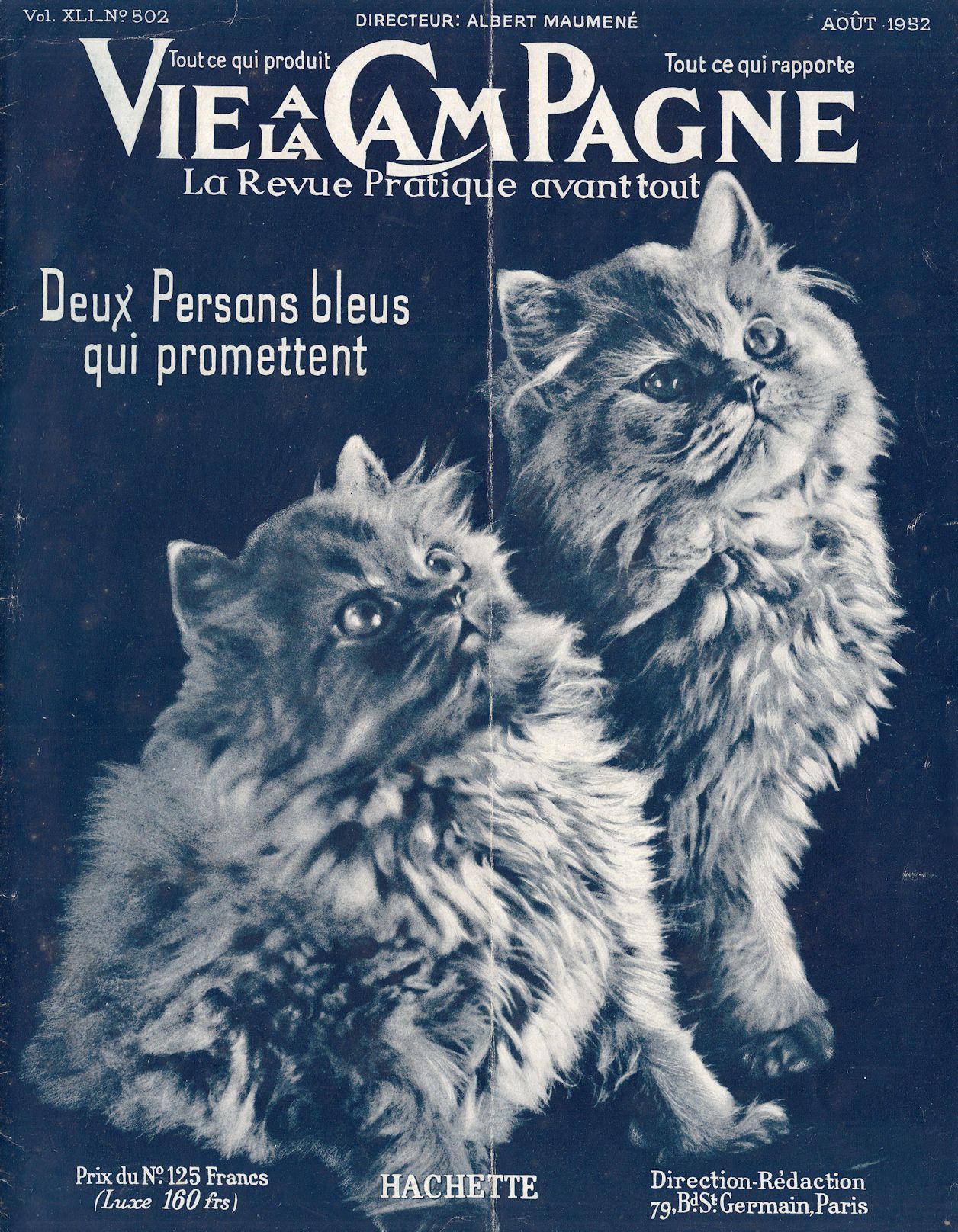
THE PRESTIGE OF THE PERSIAN CAT
VIE A LA CAMPAGNE, VOL XLI, No 502, August 1952
THREE Parisian groups are dedicated in Paris to the improvement of the feline type. Each organizes show, the proceeds of which are generally distributed to charities. Active and healthy emulation reigns between these groups. And, if there is a French Feline Federation, it is included in the International Feline Federation. The admirably selected breeds and varieties bear witness to marked improvements, especially since this Review has reserved a special issue for the feline species:
HIS HIGHNESS THE CAT
A veritable album-volume whose reputation has not been exhausted, whereas the edition has been completely impossible to find for years and is nowhere to be found (1) Vie à la Campagne, extraordinary number 92: Son Altesse le Chat (sold out). To produce this album-volume an incomparable collaboration was gathered and it brought together portraits of the most famous Cats of the time. That year, a balance, perhaps uneasy, was established between the long-haired cat breeds and the short-haired cat breeds: the Persians, on the one hand; the Siamese, on the other, each of these two groups being increased by their relatives. And, somewhat on the sidelines, the European Cats, less aristocratic, primarily utilitarian; the gutter cats with no known parentage, who like the Democrats, are the plebeians of the species.
When I open the catalog of the 25th International Exhibition in Paris, I see under the title: "The most beautiful cats in the world", which it tends to justify. For all breeds and varieties of Cats, the infinitely diverse prizes to be awarded abound. The awards are reserved for all categories: Persians, Birmans, Siamese, Europeans, because the latter also have different varieties: black, cream, brown tabby, silver tabby, tabby.
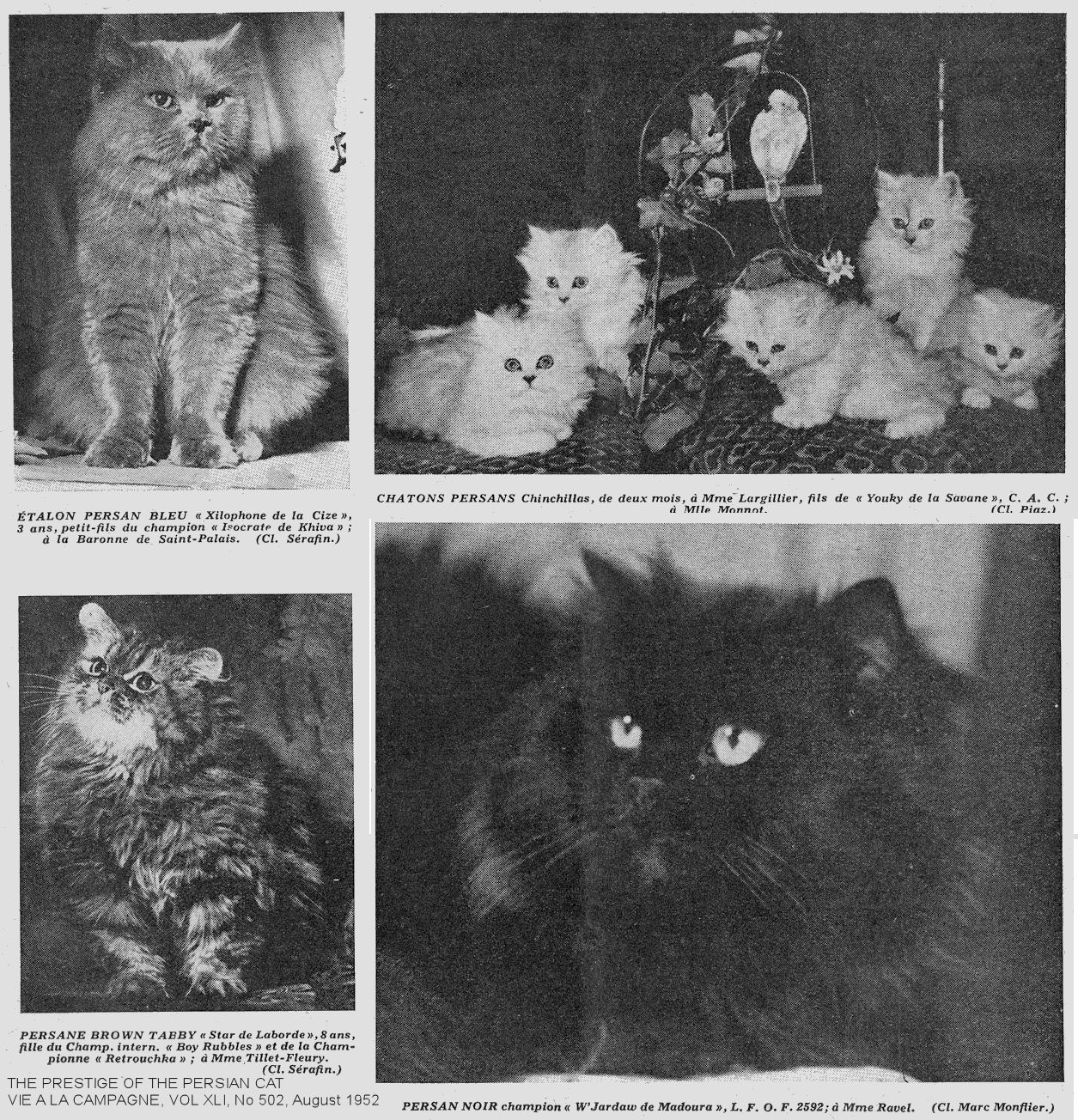
THE KINGDOM OF THE PERSIAN.
At this show, the Persian autocrats largely hold the top position, particularly the blue Persian, which the catalogue places first. Isn't there a Blue Persian Club? It is the same with this breed as it is in the mink and the silver fox: it has a respectable number of mutants. Following the blue Persian are the blue-cream; then after these come blue-eyed white, orange-eyed white, chinchilla, black, brown tabby, silver tabby, red tabby, tortoiseshell, and smoke. The Birmans follow these.
Short-haired cats include the Abyssinian, tChartreux and Russian Blue. Siamese also have their varieties: blue point and seal point (brown).
The Persian Cat is impressive due to its size and dominates the Siamese by its weight, the female in particular. I have calculated the weights that must be reached by breeding females thus: female Persian: 2.5 kg., male Persian: 3.5 kg., female Siamese cat (obviously more slender), about 2 kg., male Siamese: 3 kg.

RESPECTIVE POSITIONS.
I asked the same questions to the leaders of each of the three Parisian groupings. Here is what Ms. Ravel, Secretary General of the Feline Federation, specifies.
The demand for Persian Cats being by far the greatest and this breed being less prolific, it attains far higher prices than those quoted for the Siamese. In France, an average Persian kitten is sold for 12,000 to 15,000 fr. ; he gets a higher price abroad. A dozen high class Persians were exported this year at prices ranging from 23,000 to 28,000 fr. Sales of adult Persians were made at prices ranging from 15,000 to 50,000 fr. A blue Persian champion, sold in France, was sold for 120,000 fr. It’s a record, don’t you think!
Siamese cats from French catteries are not particularly beautiful and, in general, their market value is affected. The average price is between 3,000 and 5,000 fr. for a kitten. Kittens directly imported from England make around 12,000 fr. Breeders often sell breeding class kittens abroad and generally get 10,000 to 12,000 fr. Siamese kittens from French catteries were also exported in 1952 to South America and North America.
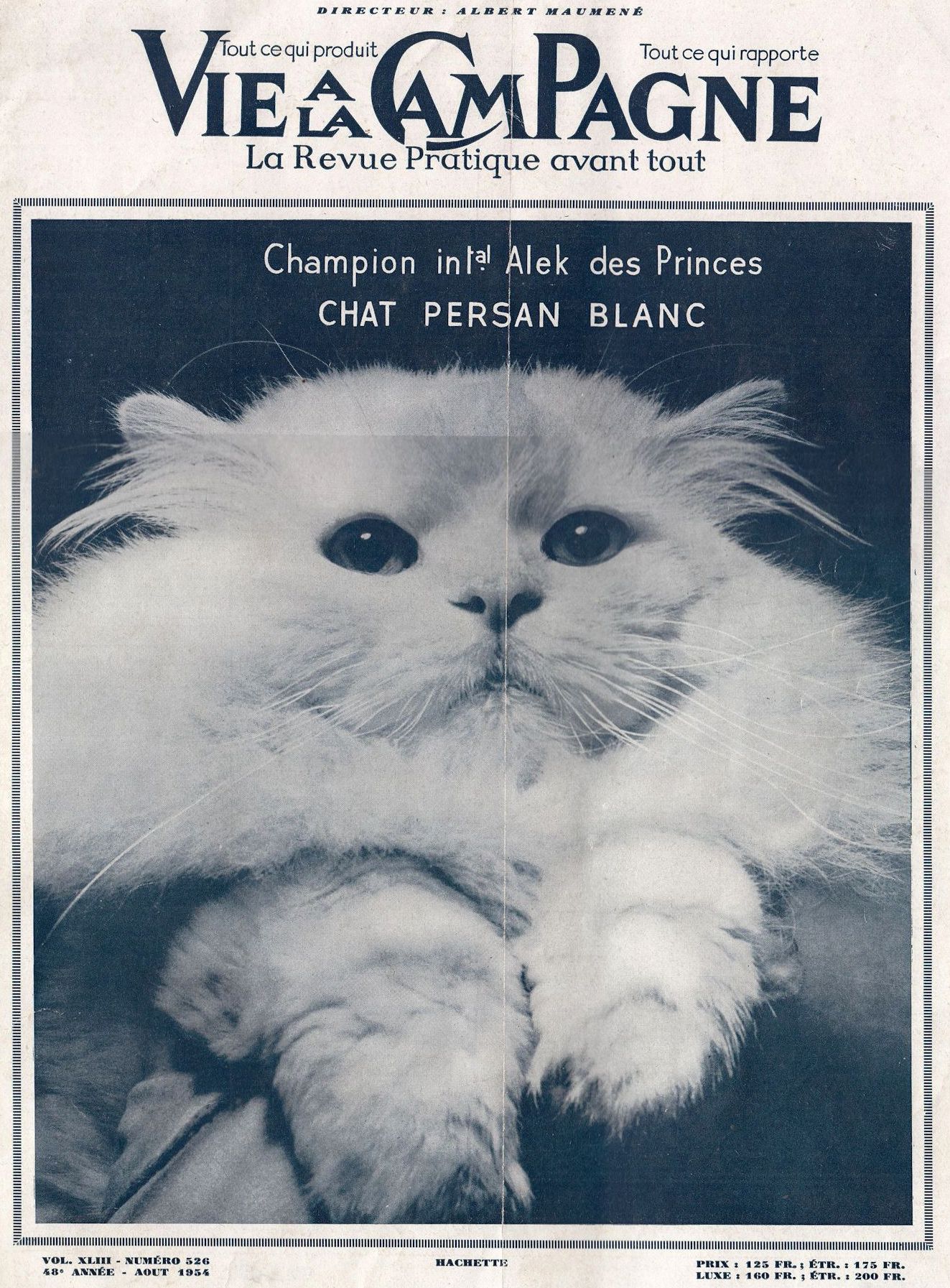
INTERNATIONAL CHAMPTION “ALEK DES PRINCES” - WHITE PERSIAN
VIE A LA CAMPAGNE. VOL XLIII – NUMBER 526, 48TH YEAR – AUGUST 1954
THE PERSIAN CAT, a breed renowned for its exceptional sweetness, deservedly enjoys prestige (Vie a la Campagne, No 502: The prestige of the Persian Cat). If the blue Persian is featured in feline exhibitions, the white Persian is no less attractive by the colour of its large, wide open eyes, azure blue, yellow or orange and by the beauty of its snow-white coat, which is silkier than that of other coloured cats.
This beautiful variety is also enjoying great success, such as that recently won by the international champion "Alek des Princes," aged 3, by taking the cup and the title of "Best Persian cat" at the event organized in the Champs Elysees by the TWA.
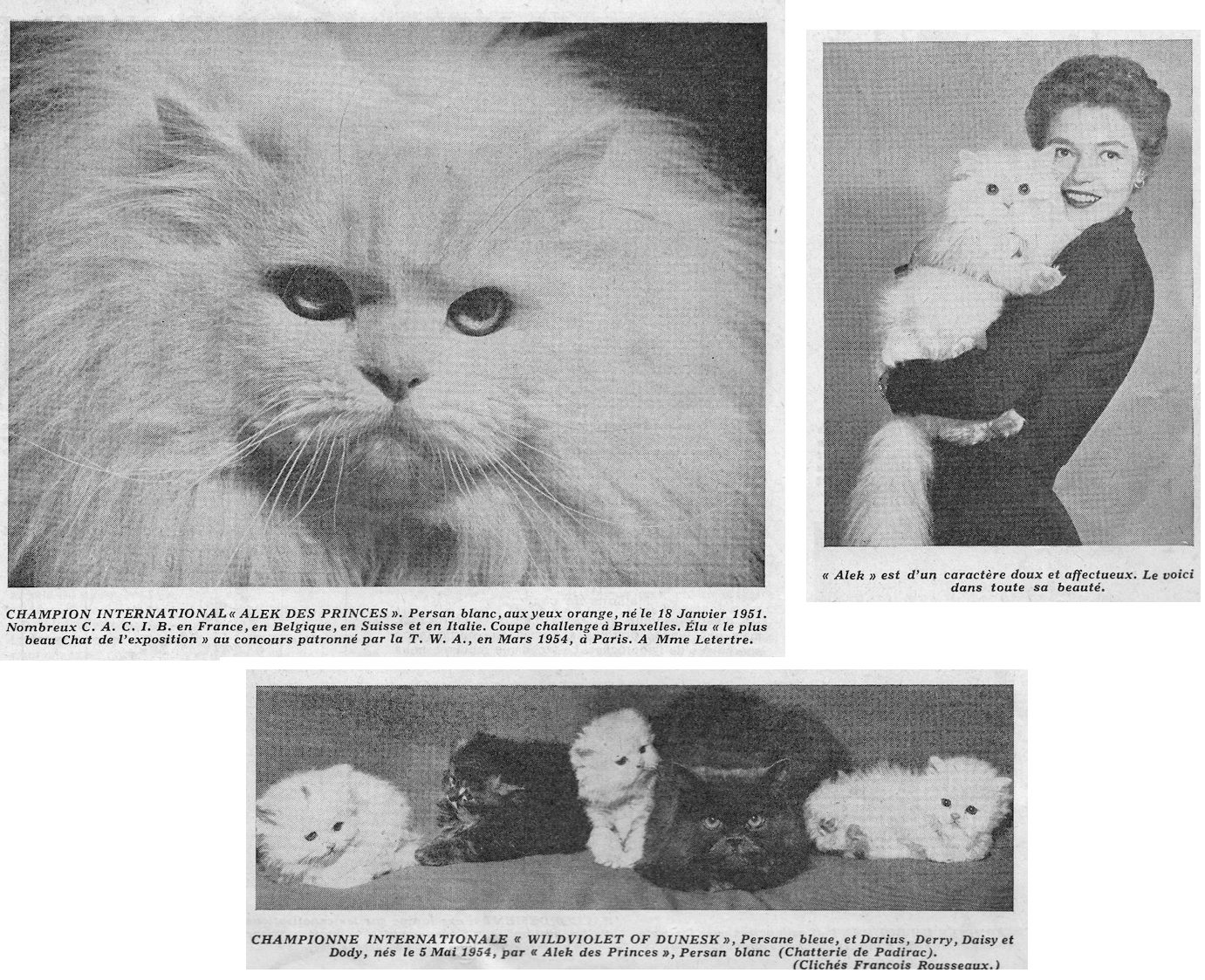
"Coming from a long line of famous Cats, Alek," says the owner, Mrs. Letertre, "has never been beaten at exhibition. Above all, he is an excellent stud cat. With a gentle and affectionate character, he patiently allows grooming with comb and brush every morning, which is essential to air his coat, given the enormous volume of fur. But you have to see him in being bathed, wisely allowing soaping, then rinsing with plenty of water, after which he stays still for a two hour electric drying session.
As soon as he is dry, this prince of Persians rushes to his hearty meal usually composed of salad, cooked leeks and carrots, all mixed with raw ground beef; but above all he prefers fish. He finds frozen cod cooked in a court-bouillon delicious, after which he loves to drink a cup of warm raw milk from a bain marie.